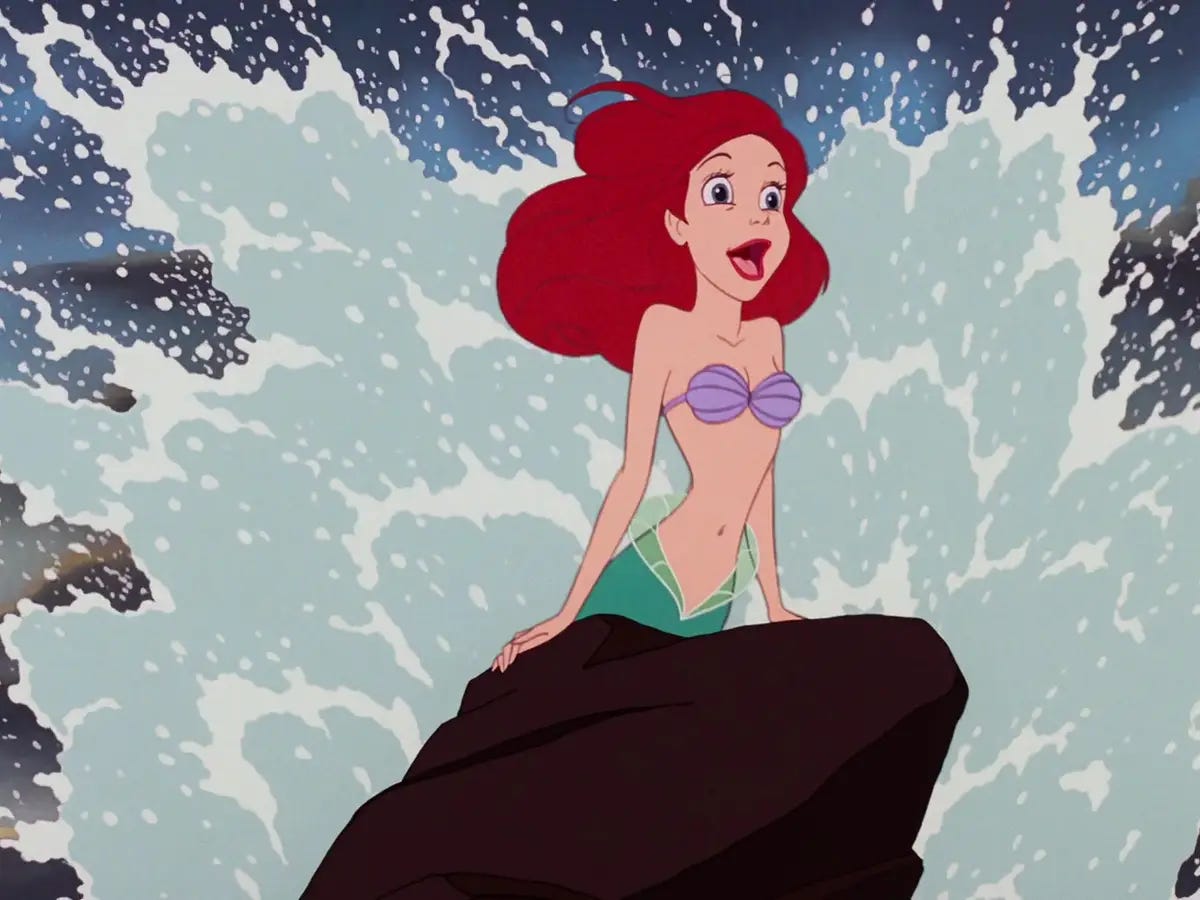Which Countries Have the Most (and Least) Uplifting Movies? A Statistical Analysis
Which countries produce the most heartwarming films, and why?
Intro: "Happily Ever After"
Denmark loves Hans Christian Andersen. On a recent trip to Copenhagen, I was surprised by the overwhelming reverence paid to The Little Mermaid author: Andersen's grave is listed as a "Thing to Do" on TripAdvisor, commemorative plaques and street names pay tribute to his life, and his most famous fairy tale is immortalized via an underwhelming statue of a humanoid-fish-lady (which scores a lowly 3.4 stars on TripAdvisor, so take that for what it's worth).
After five days of Hans Christian Andersen propaganda, I decided to learn more about this beloved Dane, which led me toward a rather unfortunate truth—apparently, Disney's Little Mermaid adaptation is starry-eyed Hollywood schmaltz.
The differences between The Little Mermaid fairy tale and Disney's reimagining are striking (to say the least):
In the Disney Film: Seeking love, Ariel endures a seamless transition to human form by giving away her voice. The film ends with Ariel winning the heart of Prince Charming, giving up her life under the sea, and somehow living "happily ever after."
In Andersen's 19th-Century Fairy Tale: Seeking spiritual transcendence and an "immortal soul," the titular mermaid experiences a painful transformation to human form and has her tongue cut out in exchange for legs. She does not win Prince Charming's heart; instead, she sacrifices herself to save him and ultimately dissolves into sea foam, though she gains her "immortal soul."
Even more mind-boggling is the fact that Andersen's tale—the parable of a mermaid's quest for spiritual enlightenment that culminates with the protagonist turning into sea bubbles—was originally written for, and eagerly consumed by, Danish children. In contrast, few American parents would soothe their kids with the story of a tongue-less fish-woman whose every step on land induces the feeling of "sharp knives."
Disney's liberal interpretation of The Little Mermaid got me thinking about happy endings and how audience expectations vary across cultures. Are certain countries more likely to produce heartwarming films—and, if so, why?
So today, we'll identify the nations with the most (and least) uplifting movies and examine the economic factors that drive these storytelling choices.
Which Countries Have the Most (and Least) Uplifting Movies?
Here's a fun conversation starter: Are Hollywood movies more likely to have "Hollywood endings," or is this stereotype a fanciful myth? And here's an even stranger question: If American films defy this stereotype, then which country produces the most feel-good "Hollywood endings"?
To quantify narrative mirth, I trained a model to parse 40,000+ Wikipedia movie summaries from over 80 countries to answer one simple question: does this story have an (unambiguously) happy ending? According to our model outputs, America's reputation for narrative optimism is well-deserved: more than half of U.S. film conclusions are decisively uplifting.
India, home to the aptly named "Bollywood," ranks second on our list. Together, the United States and India are the world's largest film producers, releasing hundreds of movies each year for a broad spectrum of audiences.
Meanwhile, a group of globally respected yet smaller-scale film industries—such as France, Spain, and Korea—top our list of countries whose movies are least likely to have a happy ending.
These divergent narrative tendencies raise questions of cause and effect: Are there tangible factors shaping a country's cinematic storytelling? And, if so, what drives these narrative decisions? Well, to borrow the immortal words of political pundit James Carville: "It's the economy, stupid."
Enjoying the article thus far and want more data-centric pop culture content?
The Global Economics of Story Endings
Modern entertainment does not come cheap. Movies demand substantial financial investment, often made with the hope of doubling or tripling an investor's money. This tension between art and commerce means a film is rarely the vision of one starving artist; instead, studio executives, financiers, and audience expectations significantly shape creative decisions. And the greater the financial investment, the more influence these stakeholders exert over the production process.
Consequently, as a movie's budget increases, so does the prevalence of happy endings.
A $100M Marvel movie must be accessible to all, and conventional wisdom dictates that "general audiences" prefer an uplifting conclusion. Spider-Man always saves the day, and Harry Potter never dies (even when he seemingly dies for a few minutes).
Furthermore, there is a symbiotic relationship between budget and genre: certain storytelling formats shape audience expectations (through decades of established conventions) and require greater financial investment. Adventure films, action movies, and fantasy spectacles—genres associated with higher budgets—naturally lend themselves to cheerful conclusions, whereas horror, crime, and drama films—which are cheaper to produce—tend to end on a more somber note.
These well-worn genre tropes foster a vicious cycle: audiences come to expect certain narrative beats, and producers cater to these expectations, which further reinforces moviegoer perception.
These ingrained expectations frequently influence viewers' perception of a film. Friend of the newsletter Stephen Follows used data from Common Sense Media to examine the correlation between an adventure film's "positive messaging" and its IMDd rating. His analysis quantifies what movie studios know all too well: If you invest hundreds of millions of dollars to have Tom Cruise hang from a plane or Scarlett Johansson battle dinosaurs, you're better off delivering a happy ending.
That said, these audience standards—and the self-perpetuating cycle they create—vary significantly by genre. In this same analysis, Follows finds a meaningful correlation between online ratings and "positive messaging" for adventure, comedy, and action, but little to no correlation for dramas, crime stories, and thrillers.
Consequently, you may notice that the genres with the strongest correlation between positive messaging and viewer appraisal—such as adventure and fantasy—are also those more likely to feature a happy conclusion. 🤯
So, how does all this relate to the prevalence of uplifting endings in different countries? Ultimately, this interplay between genre, budget, and viewer expectation brings us to our final observation: a country's narrative tendencies are shaped by the genres it most frequently produces.
When we plot countries with the highest and lowest rates of happy endings against the proportion of dramas they produce, the correlation is unmistakable: more drama means fewer heartwarming finales.
Nations that specialize in lower-budget dramas tend to produce fewer uplifting conclusions; in contrast, countries with diverse film slates—regularly featuring sci-fi, action, adventure, musicals, and animation—are more likely to deliver a happy ending.
Hollywood and Bollywood are industrial-scale film producers, delivering an array of genres to be consumed by global audiences. Conversely, Spain, Türkiye, and France have smaller film industries that are less dependent on uplifting narratives. To further complicate matters, the big-budget, crowd-pleasing movies popular in Spain and France are often Hollywood imports, thereby limiting these countries' ability to produce films of a similar scale.
America has a near-monopoly on big-budget spectacle—and big-budget spectacle almost always demands a happy ending.
Final Thoughts: Who Could Possibly Hate E.T.?
During my junior year of college, I studied abroad in the United Kingdom, enrolling as a foreign exchange student at King's College. While at King's, I took a course on "World Cinema," which began with a screening of E.T. After the film ended and the lights came up, the professor stood before the class to explain his movie selection: "This is the last piece of Hollywood popcorn garbage we'll watch." His comment was intended as reassurance, prompting audible sighs of relief from every student—except for me. How could anyone dislike E.T. or Hollywood or...America 🇺🇸??
For the next 12 weeks, we watch some of the most dour global cinema known to humanity: Oldboy (which is an awesome and disgustingly upsetting movie), multiple Lars von Trier films (who is often called cinema's "terrible child"), and La Haine (which translates to Hate). During this period, I became a human piñata in class discussions. Students would gesture toward me when pejoratively referencing Hollywood, or the notion of mainstream entertainment, or viewer simple-mindedness: "Of course, he prefers the Hollywood version."
After four months of getting dunked on by British hipsters, I began to see their point: one of America's greatest exports is a formulaic entertainment product that delivers a narrow range of uplifting outcomes. These chain-smoking, Letterboxd-loving hipsters had changed my perspective.
After working through this analysis, my perspective is decidedly less cynical. I've started seeing movie selection not as a competition among local industries but as a complementary exchange of foreign imports and domestic favorites. A film's tone does not reflect a country's collective disposition; rather, it highlights that market's demand for diverse storytelling options. From this vantage, the French and Spanish film industries are simply offering their audiences variety—delivering a somber style of storytelling rarely encountered in Hollywood imports.
Moreover, national borders no longer constrain viewer selection—nearly every film is accessible within a few remote clicks, placing Oldboy, La Haine, E.T., and Lars von Trier's filmography equally within reach (all priced at $3.99 on Amazon Prime). If you crave a change of pace, there's no shortage of global cinema offering alternative narratives.
Want to watch a tense French drama that makes you feel something? You can. Prefer an uplifting adventure epic instead? That's just as accessible. If you'd like The Little Mermaid to have a happy ending, head to Disney+. If you'd rather she lose her tongue and dissolve into sea foam, you can always pick up a book.
Struggling With a Data Problem? Stat Significant Can Help!
Having trouble extracting insights from your data? Need assistance on a data or research project? Well, you’re in luck because Stat Significant offers data consulting services and can help with:
Insights: Unlock actionable insights from your data with customized analyses that drive strategic growth and help you make informed decisions.
Dashboard-Building: Transform your data into clear, compelling dashboards that deliver real-time insights.
Data Architecture: Make your existing data usable through extraction, cleaning, transformation, and the creation of data pipelines.
Want to chat? Drop me an email at daniel@statsignificant.com, connect with me on LinkedIn, reply to this email, or book a free data consultation at the link below.
Want to chat about data and statistics? Have an interesting data project? Looking to produce data-centric editorial content? Email daniel@statsignificant.com











This single phrase sums up why I read and enjoy your newsletter:
"To quantify narrative mirth"
Some really great analysis belies an even better storyteller!